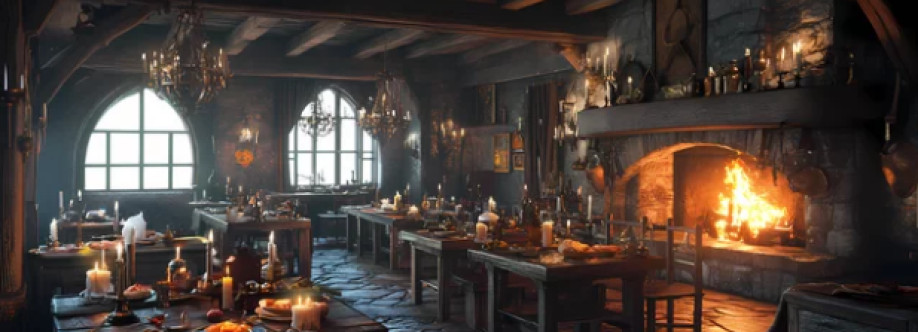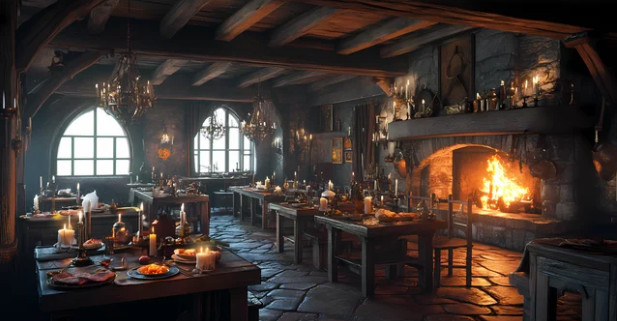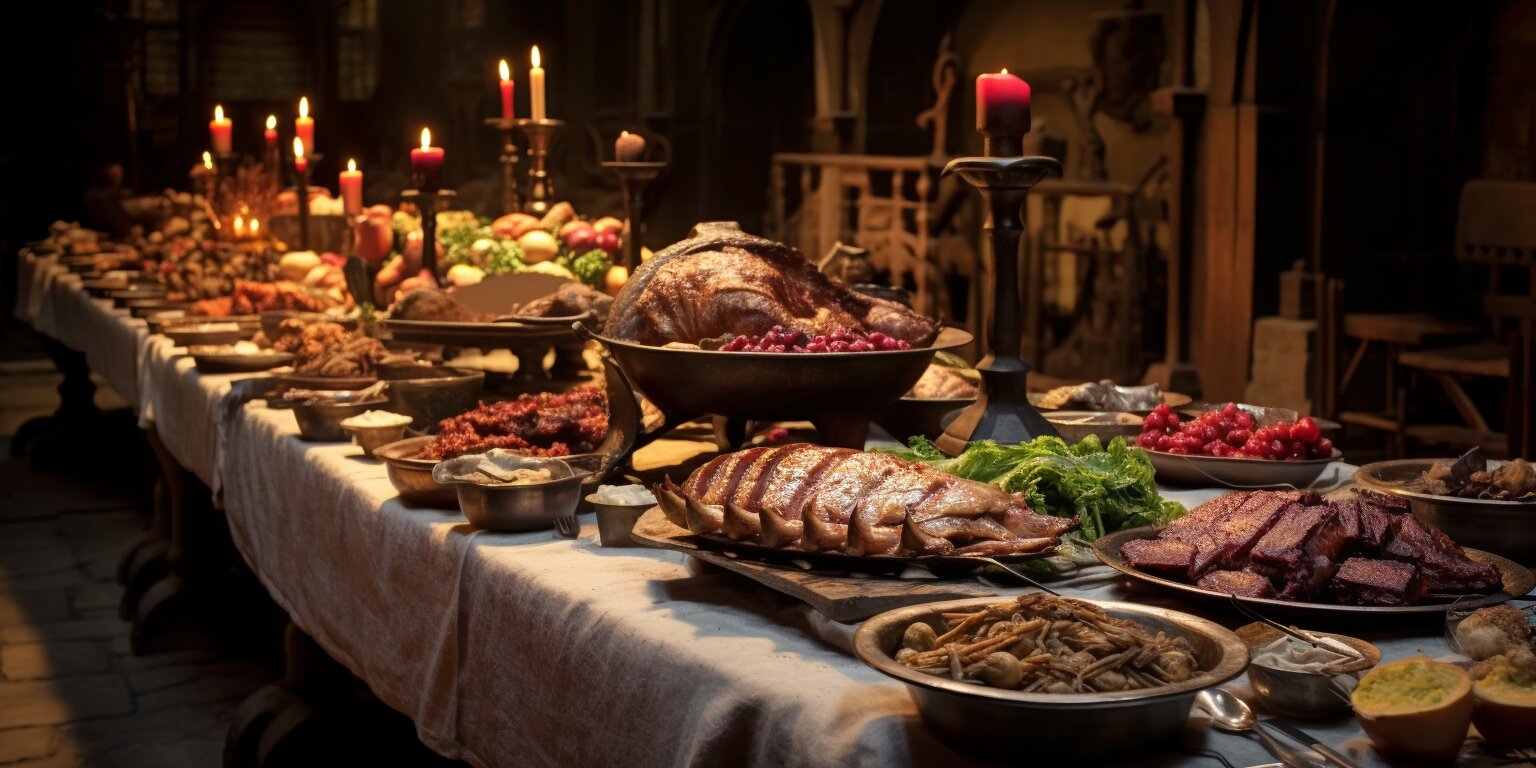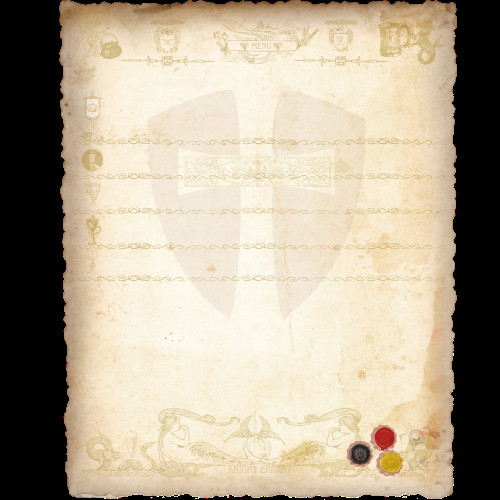Join our food and drink Transcribathon Run
Transcribe recipes and menus from our collections
Europeana is celebrating the theme of food and drink this year through stories, creative events and a Transcribathon run.
Editorials, such as Fairy tale food, The history of Les Halles food market in Paris, Celebrity food stories and The history of the croissant highlight the diverse ways food and drink marks our lives from our childhood to what we associate with certain places.
Food and drink is also tied to migration and the mixing of cultures. People throughout history have created a rich tapestry of European heritage through meals eaten and shared.
https://www.europeana.eu/en/st....ories/join-our-food-

Experience the Grandeur of a Medieval Feast Table
Step back in time and indulge in the opulence and splendor of a medieval feast table. An intrinsic part of historic celebrations and events, the medieval feast table was the centerpiece of grand banquets and lavish dinners hosted by the medieval elite. Crafted with superior artistry and skill, these tables were designed to showcase extravagance and social status.
As you explore and learn about medieval banquet tables and dining tables, you’ll discover the intricate details of design and construction, the significant role they played in showcasing luxury and abundance, and the various elements that made them unique. Whether it’s the table setting, the tableware, the food display, or the etiquette, medieval feast tables offer a glimpse into a bygone era of indulgence and celebration.
Best restaurants near me Join us on a journey through the medieval world as we explore everything about medieval feast tables ranging from their design and construction to their role in social events, the tableware and utensils used, and the food and drink displays. Unlock the secrets of one of the most fascinating parts of medieval history and submerge yourself in the grandeur of the medieval feast table.
The Significance of Medieval Feast Tables
Medieval feast tables were more than just a surface to place food and drink. They were a symbol of prestige and power, showcasing the abundant wealth of their hosts. Every detail, from the tableware to the food display, was carefully crafted to create a visually stunning dining experience that left a lasting impression on guests.
The tables themselves were often massive, ornately carved pieces of furniture that could seat dozens of people. They were designed to be the centerpiece of the feast hall, commanding attention and setting the tone for the event to come.
Medieval Tableware
Medieval tableware was just as important as the food it held. Made from a variety of materials, including silver, pewter, and even gold, the utensils and vessels used during feasts were often highly decorated with intricate designs and patterns.
Tableware was arranged in elaborately designed patterns, creating a feast for the eyes as well as the stomach. Plates were often layered, with each course served on a different plate. Goblets and cups were also carefully selected for their beauty and craftsmanship, with delicate engravings and ornate handles.
Medieval Food Display
Food display was a crucial aspect of the medieval feast, with hosts going to great lengths to showcase the bounty of their tables. Meats were often roasted whole and presented on large platters, while fruits and vegetables were artfully arranged to create colorful displays.
Serving dishes were also highly ornate, with intricate patterns and designs that added to the visual appeal of the feast. In some cases, food was even sculpted into intricate shapes and designs, turning the table into a work of art.
Medieval Table Setting
The table setting was an important part of the medieval feast experience, with each utensil and dish carefully placed in its proper location according to strict rules of etiquette. The tablecloth was often richly decorated, with elaborate embroidery and intricate designs.
Guests were seated according to their rank, with the most important guests sitting closest to the head of the table. Each course was served in a specific order, with the appropriate utensils and dishes provided for each one.
Overall, the medieval feast table was a marvel of design and craftsmanship, showcasing the wealth and power of its owner while providing a memorable experience for all who attended.
Design and Construction of Medieval Feast Tables
The design and construction of medieval feast tables were both functional and ornate. These tables were typically made from fine woods, such as oak or walnut, and were constructed to withstand the weight of elaborate feasts and the constant wear and tear of daily use. The tables were often large, rectangular in shape, and could seat numerous guests
Medieval feast decor was equally lavish, featuring ornate carvings and intricate designs that were carefully crafted to showcase the wealth and status of the host. The legs of the tables were often intricately carved, and many featured decorative motifs that were popular during the medieval period, such as dragons or lions.
The tops of the tables were typically made from planks of wood that were joined together to create a smooth surface. Many tables were also covered with a tablecloth made of linen or silk to protect the wood and to add an additional layer of elegance to the design. Tablecloths were often embroidered with intricate patterns and designs, adding to the overall beauty of the table.
Medieval Feast Furniture
Medieval feast furniture was not limited to just tables. Other furniture pieces that were commonly found in medieval feast halls included benches, stools, and chairs. These pieces were often made from the same fine woods as the tables and were carved with similar decorative motifs.
Medieval Feast Furniture Description
Benches Long, narrow seats without backs, designed to seat multiple people at once.
Stools Small, portable seats were often used by servants or other guests who didn’t require a full chair.
Chairs Individual seats with backs were typically reserved for the host and other high-ranking guests.
Overall, the design and construction of medieval feast tables and furniture were a testament to the skill and artistry of the craftsmen who created them. Their practicality and durability ensured that they were able to withstand the test of time, while their ornate decorations and intricate details continue to captivate and inspire us today.
Elements of a Medieval Feast Table
The medieval feast table was a remarkable and elaborate installation designed to accommodate the grandeur and extravagance of the dining experience. It consisted of several components that were strategically arranged to suit the needs of the hosts and guests.
The main table of a medieval feast was the central piece of the dining hall. It was often a long, rectangular table that could seat a significant number of guests together. The table was ornately decorated with rich fabrics, fine tableware, and shiny silverware, laid out to create a visually opulent ambiance.
Additional tables, known as auxiliary tables, were placed at the end of the room or along the walls to hold an array of food and drink. These tables were used to supplement the main table, ensuring that guests could easily access the delicacies on offer.
Another essential component of a medieval feast table was the serving platform. These raised platforms were placed at strategic points throughout the dining hall, allowing hosts and servers to display the culinary delights of the feast. Positioned around the room, these platforms ensured that guests were never too far from the food and drink on offer.
The layout of the medieval feast tables was as much a part of the dining experience as the food and drink themselves. The arrangement allowed guests to mingle, socialize, and enjoy the company of their fellow diners. It created a communal atmosphere that made the meal more than just a meal but a significant event, an experience worth remembering.
In summary, the elements of a medieval feast table worked together to create a unique and immersive dining experience. Hosts and guests alike could revel in the splendor and luxury of the occasion, enjoying the food, drink, and company of each other in the most indulgent and opulent ways possible. This was truly a one-of-a-kind dining experience, one that has been celebrated and admired for generations.
Tableware and Utensils of the Medieval Feast Table
Medieval tableware was a key component in creating an opulent dining experience for the elite. Nobles and royals alike were presented with a variety of utensils and vessels to showcase their status and wealth.
The most common utensils included knives, spoons, and forks, although forks were not widely used until the late medieval period. Instead, guests would often eat with their hands or use bread as a makeshift utensil.

Experience the Grandeur of a Medieval Feast Table
Step back in time and indulge in the opulence and splendor of a medieval feast table. An intrinsic part of historic celebrations and events, the medieval feast table was the centerpiece of grand banquets and lavish dinners hosted by the medieval elite. Crafted with superior artistry and skill, these tables were designed to showcase extravagance and social status.
As you explore and learn about medieval banquet tables and dining tables, you’ll discover the intricate details of design and construction, the significant role they played in showcasing luxury and abundance, and the various elements that made them unique. Whether it’s the table setting, the tableware, the food display, or the etiquette, medieval feast tables offer a glimpse into a bygone era of indulgence and celebration.
Best restaurants near me Join us on a journey through the medieval world as we explore everything about medieval feast tables ranging from their design and construction to their role in social events, the tableware and utensils used, and the food and drink displays. Unlock the secrets of one of the most fascinating parts of medieval history and submerge yourself in the grandeur of the medieval feast table.
The Significance of Medieval Feast Tables
Medieval feast tables were more than just a surface to place food and drink. They were a symbol of prestige and power, showcasing the abundant wealth of their hosts. Every detail, from the tableware to the food display, was carefully crafted to create a visually stunning dining experience that left a lasting impression on guests.
The tables themselves were often massive, ornately carved pieces of furniture that could seat dozens of people. They were designed to be the centerpiece of the feast hall, commanding attention and setting the tone for the event to come.
Medieval Tableware
Medieval tableware was just as important as the food it held. Made from a variety of materials, including silver, pewter, and even gold, the utensils and vessels used during feasts were often highly decorated with intricate designs and patterns.
Tableware was arranged in elaborately designed patterns, creating a feast for the eyes as well as the stomach. Plates were often layered, with each course served on a different plate. Goblets and cups were also carefully selected for their beauty and craftsmanship, with delicate engravings and ornate handles.
Medieval Food Display
Food display was a crucial aspect of the medieval feast, with hosts going to great lengths to showcase the bounty of their tables. Meats were often roasted whole and presented on large platters, while fruits and vegetables were artfully arranged to create colorful displays.
Serving dishes were also highly ornate, with intricate patterns and designs that added to the visual appeal of the feast. In some cases, food was even sculpted into intricate shapes and designs, turning the table into a work of art.
Medieval Table Setting
The table setting was an important part of the medieval feast experience, with each utensil and dish carefully placed in its proper location according to strict rules of etiquette. The tablecloth was often richly decorated, with elaborate embroidery and intricate designs.
Guests were seated according to their rank, with the most important guests sitting closest to the head of the table. Each course was served in a specific order, with the appropriate utensils and dishes provided for each one.
Overall, the medieval feast table was a marvel of design and craftsmanship, showcasing the wealth and power of its owner while providing a memorable experience for all who attended.
Design and Construction of Medieval Feast Tables
The design and construction of medieval feast tables were both functional and ornate. These tables were typically made from fine woods, such as oak or walnut, and were constructed to withstand the weight of elaborate feasts and the constant wear and tear of daily use. The tables were often large, rectangular in shape, and could seat numerous guests
Medieval feast decor was equally lavish, featuring ornate carvings and intricate designs that were carefully crafted to showcase the wealth and status of the host. The legs of the tables were often intricately carved, and many featured decorative motifs that were popular during the medieval period, such as dragons or lions.
The tops of the tables were typically made from planks of wood that were joined together to create a smooth surface. Many tables were also covered with a tablecloth made of linen or silk to protect the wood and to add an additional layer of elegance to the design. Tablecloths were often embroidered with intricate patterns and designs, adding to the overall beauty of the table.
Medieval Feast Furniture
Medieval feast furniture was not limited to just tables. Other furniture pieces that were commonly found in medieval feast halls included benches, stools, and chairs. These pieces were often made from the same fine woods as the tables and were carved with similar decorative motifs.
Medieval Feast Furniture Description
Benches Long, narrow seats without backs, designed to seat multiple people at once.
Stools Small, portable seats were often used by servants or other guests who didn’t require a full chair.
Chairs Individual seats with backs were typically reserved for the host and other high-ranking guests.
Overall, the design and construction of medieval feast tables and furniture were a testament to the skill and artistry of the craftsmen who created them. Their practicality and durability ensured that they were able to withstand the test of time, while their ornate decorations and intricate details continue to captivate and inspire us today.
Elements of a Medieval Feast Table
The medieval feast table was a remarkable and elaborate installation designed to accommodate the grandeur and extravagance of the dining experience. It consisted of several components that were strategically arranged to suit the needs of the hosts and guests.
The main table of a medieval feast was the central piece of the dining hall. It was often a long, rectangular table that could seat a significant number of guests together. The table was ornately decorated with rich fabrics, fine tableware, and shiny silverware, laid out to create a visually opulent ambiance.
Additional tables, known as auxiliary tables, were placed at the end of the room or along the walls to hold an array of food and drink. These tables were used to supplement the main table, ensuring that guests could easily access the delicacies on offer.
Another essential component of a medieval feast table was the serving platform. These raised platforms were placed at strategic points throughout the dining hall, allowing hosts and servers to display the culinary delights of the feast. Positioned around the room, these platforms ensured that guests were never too far from the food and drink on offer.
The layout of the medieval feast tables was as much a part of the dining experience as the food and drink themselves. The arrangement allowed guests to mingle, socialize, and enjoy the company of their fellow diners. It created a communal atmosphere that made the meal more than just a meal but a significant event, an experience worth remembering.
In summary, the elements of a medieval feast table worked together to create a unique and immersive dining experience. Hosts and guests alike could revel in the splendor and luxury of the occasion, enjoying the food, drink, and company of each other in the most indulgent and opulent ways possible. This was truly a one-of-a-kind dining experience, one that has been celebrated and admired for generations.
Tableware and Utensils of the Medieval Feast Table
Medieval tableware was a key component in creating an opulent dining experience for the elite. Nobles and royals alike were presented with a variety of utensils and vessels to showcase their status and wealth.
The most common utensils included knives, spoons, and forks, although forks were not widely used until the late medieval period. Instead, guests would often eat with their hands or use bread as a makeshift utensil.
link: https://knightstemplar.co/expe....rience-the-grandeur-
Medieval Tavern "Knight Errant"«®»
Network of Medieval taverns on the path of heroic wanderings and adventures of brave Errant Knights

